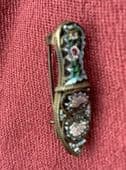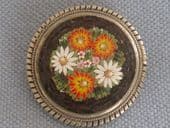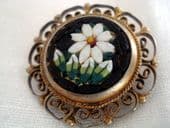MICRO MOSAIC BROOCHES AND PINS - 19TH CENTURY TO CONTEMPORARY - CLICK HERE TO BROWSE
Micro Mosaic is an Italian inlaid glass technique often used to decorate the beautiful and elaborate church alters and perfected to provide souvenirs for the tourist trade back in the late 1700s and early1800s. Back then rich people often went on a "Grand Tour" around Europe to visit important and impressive sites and cities! The early Antique Micro Mosaic jewellery pieces often show classical and architectural subjects or people in national dress as well as place names.
In the early19th Century it was usual to make the pictures up out of hundreds of tiny coloured glass pieces and tiles (Tessarae) and mount them into a solid glass background. Customers could then decide whether to take the piece unmounted and arrange for their own Jeweller back home to make up a setting or to purchase the item complete - as a brooch etc. By the end of the 19th Century pieces were also being made up to cater for a growing tourist market of less weathy people. Craftsmen began mounting the work in non-precious metals such as gilded brass . In the Victorian period jewellery and items like photo frames and desk ware were made up in Micro Mosaic in Britain and other European countries too. By and large though the style and technique belong to Italy and Micro Mosaic jewels are still made in Italy today. They are collected the world over and it is easy to see why they appeal.......


















